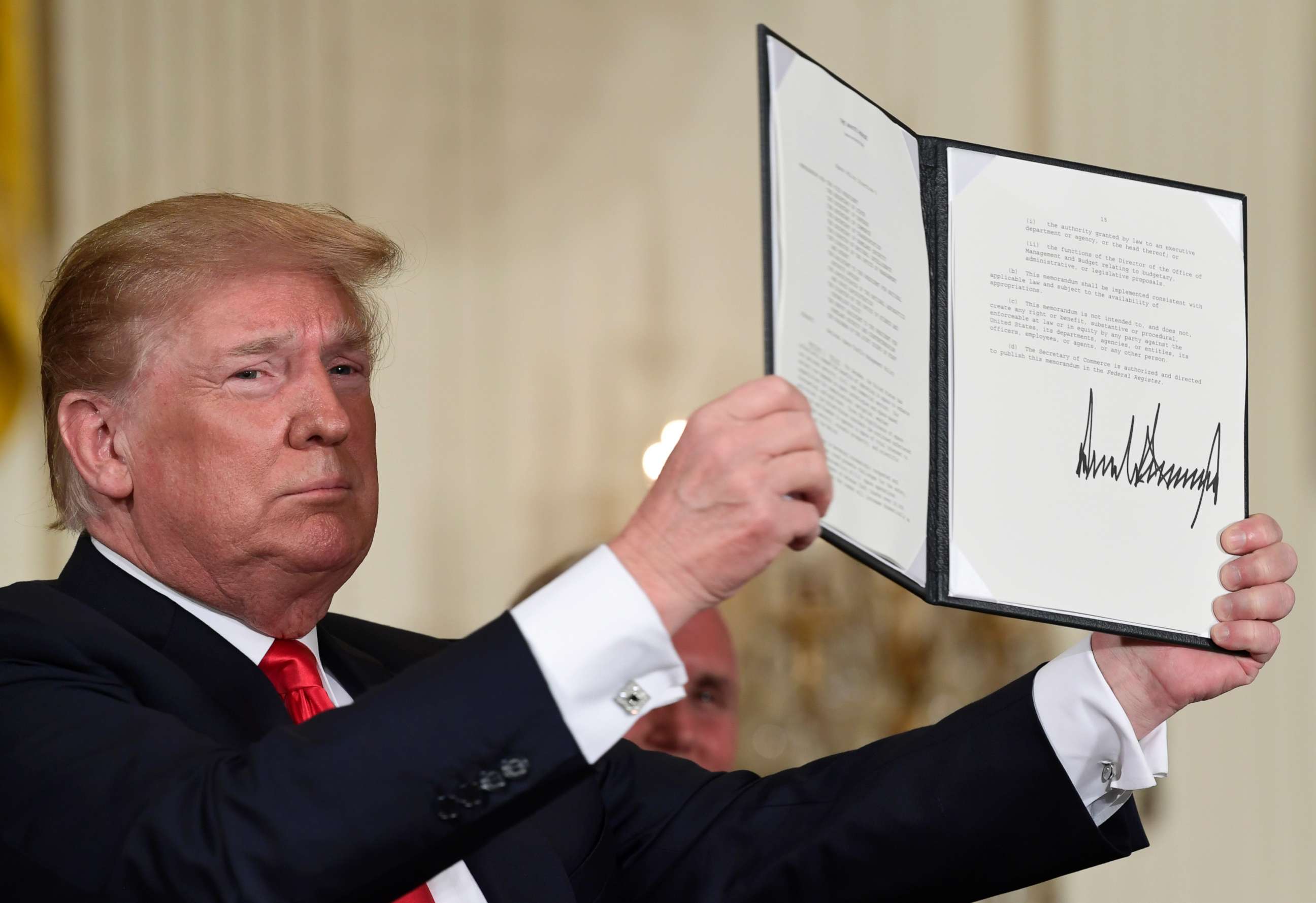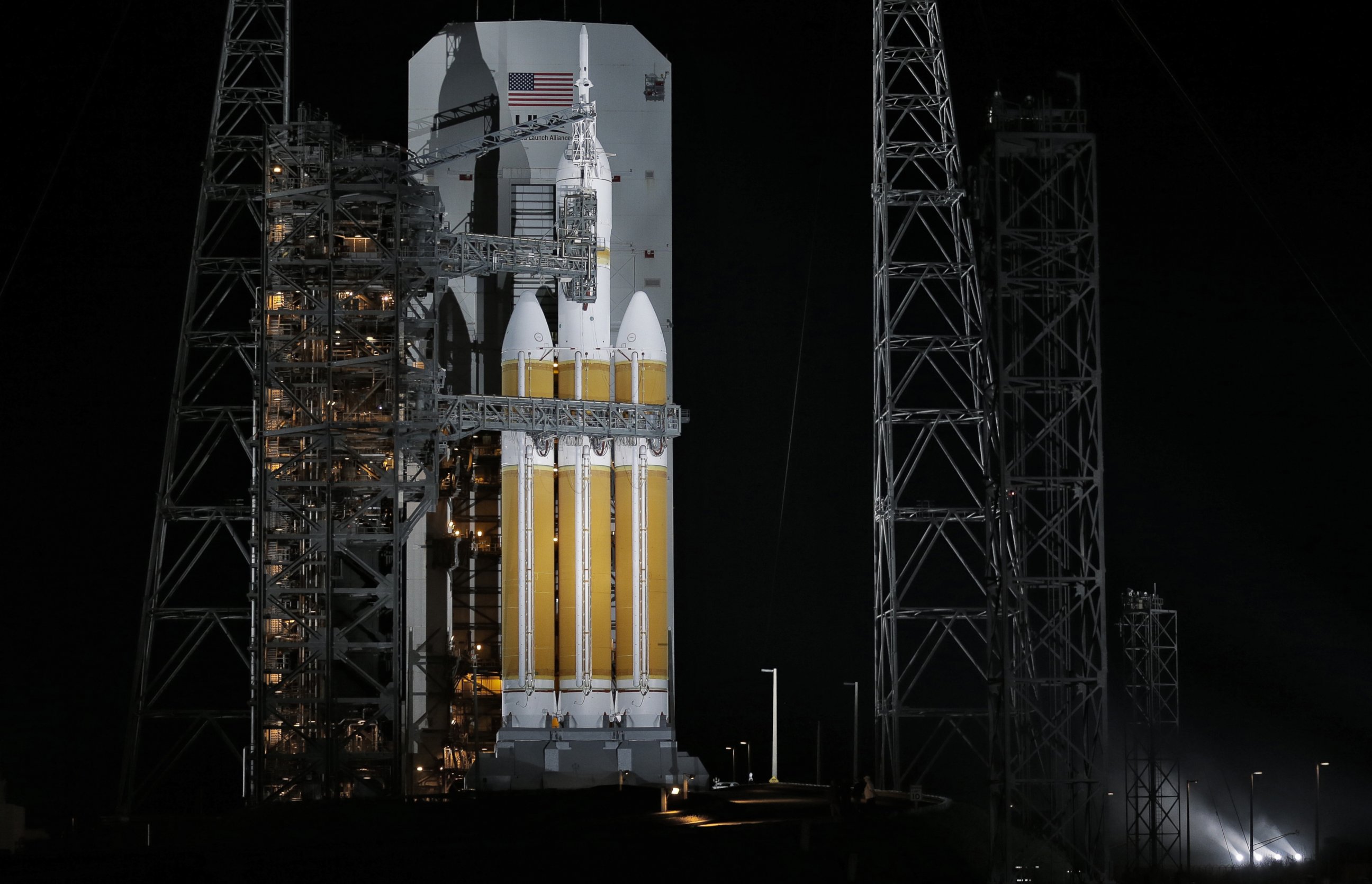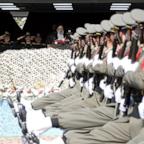President Trump's 'space force' prepares for launch
Trump's call for a “space force” may come one step closer to reality this week.
President Donald Trump’s call for a “Space Force” may sound like something out of this world, but it’s set to come one step closer to reality this week when the Pentagon is expected to deliver to Congress its plans to strengthen the Defense Department’s space efforts.
But when announced on Thursday the Pentagon’s plan could fall short of Trump’s stated wish to add a sixth military service, which would require an act of Congress.
According to a White House official, Vice President Mike Pence will unveil the plan during a speech at the Pentagon on Thursday.
The expected report comes after President Trump made a surprise announcement during a National Space Council meeting in June that he was directing the military to undertake the galactic mission.
“I'm hereby directing the Department of Defense and Pentagon to immediately begin the process necessary to establish a space force as the sixth branch of the armed forces. That's a big statement. We are going to have the Air Force and we are going to have the Space Force – separate but equal. It is going to be something,” President Trump said at the June 18th meeting, scanning the room and locking eyes with Joint Chiefs of Staff Chair Gen Joseph Dunford: “General? Got it?”
“We got it,” Dunford responded to the commander-in-chief.
While the functions of an imagined Space Force are already being carried out – at least in part - by the Air Force, President Trump has argued that an additional military service is the answer to addressing the nation’s military vulnerabilities in space.
"The Air Force is going to focus on the Air Force. We need a separate branch, and we're working on that. It's called the Space Force, which is very exciting. People love it, people love it, they get it, and they love it,” the president said on July 5.
President Trump ultimately cannot add a sixth service without Congressional approval, but the Pentagon is moving forward to the extent that is already within the executive branch’s authority to stand up certain elements of a future Space Force.
Last week the military-focused news outlet Defense One exclusively reported on a draft of the Pentagon’s plans that called for the creation of a new combatant command for space, a new joint agency for satellite purchases, and a new warfighting community that draws space operators from all service branches.
An administration official confirmed to ABC News that ”all three of those things are in the option box” of the administration's report that is set to go to Congress this week and that the administration believes are all within the executive branch’s authority to carry out unilaterally. Steps further down the line, the official said, will include a formal legislative proposal and budget request that would require Congressional cooperation.
On Tuesday, Defense Secretary James Mattis expressed support for the idea of creating a new combatant command dedicated to space. Such a move would elevate space to the same level as the regional commands like U.S. Central Command for the Middle East and topic-based commands like Cyber Command. But it would fall short of establishing a new military service dedicated to space as President Trump has advocated.
Asked if he supports establishing a combatant command for space, Mattis told Pentagon reporters, "Yes. Absolutely, we need to address space as a developing war fighting domain, and a combatant command is certainly one thing that we can establish."
"We are in complete alignment with the president's concern about protecting our assets in space and contribute to our security, our economy" said Mattis. "And we're going to have to address it as other countries show a capability to attack those assets."
Mattis noted that the Pentagon is in "complete agreement" with the White House and has been working with Pence's office and Capitol Hill to find solutions to the issueHe said the final organization of a Space Force will be "fit for purposes," but offered no timeline on its final creation.
The administration's new focus on creating a Space Force is a departure from its posture on the utility of a new space-focused unit within the military just a year ago. When the idea of creating a space corps within the Air Force was brought before Congress in 2017, Defense Secretary Jim Mattis rejected the idea as a superfluous “additional organizational and administrative tail” on the military.
“At a time when we are trying to integrate the department’s joint warfighting functions, I do not wish to add a separate service that would likely present a narrower and even parochial approach to space operations,” Mattis said in a 2017 letter responding to Rep. Michael R. Turner, R-Ohio, who who has spearheaded the congressional effort in favor of Space Corps.
What’s changed since then is that President Trump has become increasingly focused on the subject and concluded that a new military branch is needed.
The president first started publicly mulling the idea of creating a Space Force earlier this year, making one of his first public remarks on the topic during an address to Marines in March. He then moved to sign an executive order calling on the Pentagon to move forward with his vision in June.

“Space is a war-fighting domain just like the land, air, and sea,” the president said. “We may even have a space force—develop another one—space force. We have the Air Force, we’ll have the Space Force. We have the Army, the Navy.”
The original report to Congress was due on August 1, but was subsequently delayed. Asked last week about reported frictions between the White House and the Pentagon on the issue, White House Press Secretary Sarah Sanders said the process of finding an agreeable solution was ongoing.
“We're continuing to work with the Department of Defense to figure out and determine the best way forward, something the president feels strongly about, and we're going to work with our team there, and figure out the best solution,” Sanders said.
An administration official, speaking on the condition of anonymity, described the back-and-forth between the Pentagon and White House as part of the “normal course” of business in producing a major report to Congress and described it as a “constructive” process.
“The back and forth is obviously is an intense process, it takes a lot of discussion, so I think what everyone is seeing is there’s a lot of public discussion on this topic,” the official said, noting that the president’s public comments on the issue have provided clarity in developing a proposal that is in line with the president’s vision. Pentagon spokesperson Col. Rob Manning told reporters on Monday that the Department of Defense would get the report to Congress “as soon as possible,” but wouldn’t elaborate further on the cause for delay.
Since the president’s public declarations of support for a Space Force earlier this year, Secretary Mattis has also publicly changed his tune on the issue. He told Congress in April that he is open to the idea, even as he has also voiced a level of skepticism about whether adding another bureaucratic branch to the military is needed.
"If a Space Force is the right thing to do, I have no reservations about it. But I don't want to stand up in DoD, which is an enormous bureaucracy and has many sub bureaucracies, another bureaucracy as if that will be the solution,” Mattis said. “Do we want to set up another force and we have to make certain it solves the problem before we put out the money for an entirely new military, from recruiting to training and everything else, it might be the right thing to do though."
As the Pentagon now works to implement the president’s vision, the former Air Force secretary during the Obama administration, Deborah Lee James, asserted recently that the top brass of the military remain privately opposed.
“None of them are in favor of a Space Force, I say none of the top leaders, but they’re stuck,” James said in reference to the Pentagon’s leadership during a July event at the Brookings Institute. “The President has said it and it’ll be interesting to see how they now deal with it.”

But the current secretary of the Air Force, Heather Wilson, has publicly expressed openness to the idea of a Space Force following the president’s directive, despite previously angling to keep the space domain under the command of the Air Force. Wilson has praised the president for raising public awareness about the unique military threats posed in space.
“Both the chief of staff and I are actually very glad that … people are becoming more aware and having a debate about what we do about this as a nation, and that just wasn’t really there before,” Wilson said during a Washington Post event in July.
As the highest ranking civilian currently overseeing the military’s space-based operations, Wilson has warned about the real and present vulnerabilities posed in space.
The U.S. military currently has 77 satellites in orbit that could be vulnerable to potential attack from adversaries like Russia and China that have taken aggressive postures in space. She pointed to China’s successful demonstration in 2007 of its capabilities to explode satellites through the use of a guided missile, a move that was condemned by the US and other nations at the time, as a particularly troubling development.
“The United States is determined to protect our capability on orbit, we’re going to defend ourselves, and we’re developing the capability to do that,” Wilson said before delivering a message to the nation’s adversaries: “I want them to have no doubt, if they seek to contest the United States in space that we will defend ourselves.”
NASA administrator Jim Bridenstine has also echoed Wilson’s warnings that America’s adversaries are looking at the United States’ vulnerabilities in space as a military advantage, saying the Chinese have called space the American Achilles heel and the president is right to be focused on hardening the U.S. military posture in space.
“Our very way of life is dependent on space,” Bridenstine said in a recent interview with CBS News. “The way we navigate, the way we communicate over the horizon communications, the way we produce food, the way we produce energy, the way we do disaster relief and in fact the way we do banking in the USA, if we lose the GPS signal, there are no inner bank transfers, that means there will be no milk in the grocery stores, our way of life shuts down, and that’s why hostile countries around the world are taking action to make these capabilities vulnerable for the USA.”
Bridenstine supports the president’s call for creating a Space Force as NASA administrator and also voted in support of creating a Space Corps within the Air Force when he was a member of Congress.
While there is broad recognition of the necessity of protecting the U.S. military’s assets in space – with satellites playing a central role in modern everyday life and military operations – there remains vigorous debate about the virtues of creating a separate military branch.
Senators James Inhofe, R-Oklahoma, and Mike Rounds, R-South Dakota, who are both on the Armed Services Committee, have indicated that they would not be likely to support a separate branch.
Former Secretary James, for one, argues that creating a new branch of the military does not increase the military’s effectiveness in space missions, though she is supportive of propping up a unified command to orchestrate space-focused military missions.
“A military service trains, organizes, and equips, it doesn’t war fight. The combatant commands do the war fight,” James said. “I am much more in favor of that approach because I think that would really be the ticket for solving the problem that everyone is mostly focused on.”
The idea of a separate space-focused combatant command is included in the Pentagon’s August report to Congress, according to the administration official.
Testifying before the House Armed Services Committee in March, the former deputy assistant secretary of defense for space policy similarly pushed back on the creation of a separate Space Corps.
"Space is a different kind of domain than air," Doug Loverro told the committee during a hearing on space warfighting readiness. "We don't need to move it out of the Air Force in order to go ahead and create the space-smart civilian and military force that we need.”
Retired NASA astronaut Scott Kelly, who also served 25 years in the Navy, blasted the concept of creating a Space Force as an expensive, and likely redundant, undertaking.
“Any time you add more bureaucracy to an already large bureaucracy, it's going to cost a lot of money. I think the capability we're talking about is something that probably already exists in the U.S. military, in the Air Force, Navy, other armed services,” Kelly said in an interview with NBC. "It's not clear to me what the purpose is of this new branch of the military, which is going to be incredibly expensive.”
Even as the Pentagon gets underway in laying the groundwork for a Space Force, the crucial step of actually creating a 6th service branch won’t be up for serious consideration on Capitol Hill until next year. Congress recently finalized the 2019 National Defense Authorization Act that outlines funding and organization of the military. It made no mention of a separate Space Force.




